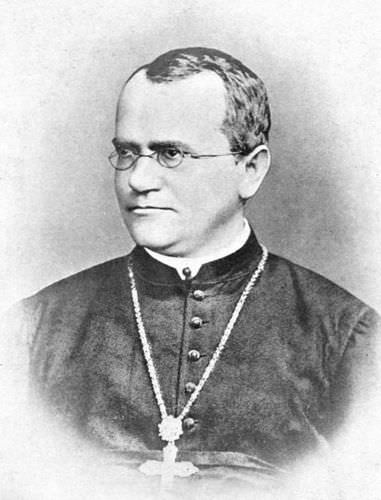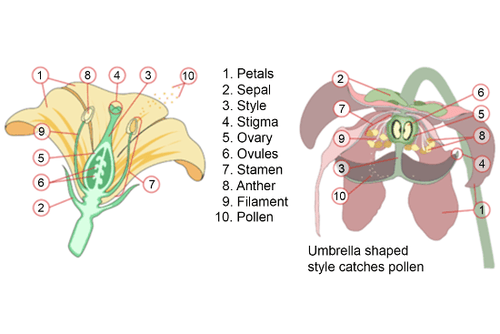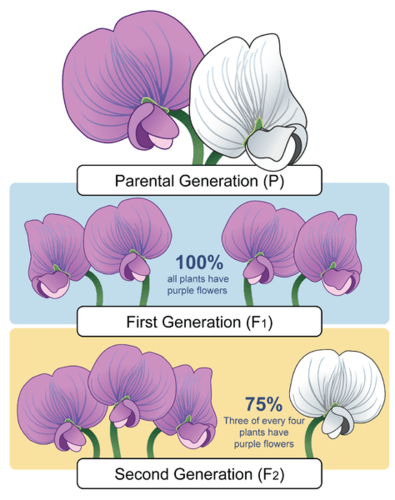5.9 门德尔实验和继承法
章节大纲
-
Of Peas and People
::农民和人民组织These purple-flowered plants are not just pretty to look at. Plants like these led to a huge leap forward in biology . T hey're common garden peas, and they were studied in the mid-1800s by an Austrian monk named Gregor . Through careful experimentation , Mendel uncovered the secrets of heredity , or how parents pass characteristics to their offspring. You may not care much about heredity in pea plants, but you probably care about your own heredity. Mendel's discoveries apply to people, as well as to peas — and to all other living things that reproduce sexually. In this concept, you will read about Mendel's and the secrets of heredity that he discovered.
::这些紫花植物不光是看得漂亮。 像这样的植物导致生物学的飞跃。 这些植物是普通的菜豆, 在1800年代中期由一位名叫Gregor的奥地利和尚研究过。 通过仔细的实验, Mendel 发现了异端的秘密, 或者父母如何把异端特性传给后代。 你也许不太关心豆植物中的异端, 但你可能关心自己的异端。 Mendel 的发现适用于人, 以及豆类, 以及所有其他繁殖性病的生物。 在这个概念中, 你会读到Mendel 及其发现的异端的奥秘。Mendel and His Pea Plants
::门德尔和他的皮皮植物Gregor Mendel (shown ) was born in 1822. He grew up on his parents’ farm in Austria. He did well in school and became a monk, and went on to the University of Vienna, where he studied science and math. His professors encouraged him to learn science through experimentation, and to use math to make sense of his results. Mendel is best known for his experiments with pea plants (like the purple flower pictured above).
::格雷戈尔·门德尔(Gregor Mendel)出生于1822年,他在奥地利的父母农场长大。他在学校表现良好,成为和尚,并前往维也纳大学学习科学和数学。他的教授鼓励他通过实验学习科学,并运用数学来理解他的结果。 曼德尔以他用豆子植物(如上面的紫花)做实验而闻名。Gregor Mendel. The Austrian monk Gregor Mendel experimented with pea plants. He did all of his research in the garden of the monastery where he lived.
::Gregor Mendel. 奥地利和尚Gregor Mendel在他居住的修道院的花园里做了所有研究。Blending Theory of Inheritance
::混合继承理论During Mendel's time, the blending theory of inheritance was popular. According to this theory, offspring have a blend (or mix) of their parents' characteristics. Mendel, however, noticed plants in his own garden that weren’t a blend of the parents. For example, a tall plant and a short plant had offspring that were either tall or short — not medium in height. Observations such as these led Mendel to question the blending theory. He wondered if there was a different underlying principle that could explain how characteristics are inherited. He decided to experiment with pea plants to find out. In fact, Mendel experimented with almost 30 thousand pea plants over the next several years!
::在孟德尔时代,继承的混合理论很受欢迎。 根据这一理论,后代具有父母特性的混合(或混合 ) 。 但是,门德尔注意到自己花园里的植物不是父母的混合物。例如,一棵高的植物和一株短的植物的后代要么高,要么短,要么高,而不是中等。这样的观察结果导致门德尔质疑混合理论。他想知道是否有不同的基本原则可以解释遗传特征。他决定试验豆类植物以找出答案。事实上,门德尔在未来几年里试验了近3万棵豆子作物!Why Study Pea Plants?
::为何要学习培豆植物?Why did Mendel choose common, garden-variety pea plants for his experiments? Pea plants are a good choice because they are fast-growing and easy to raise. They also have several visible characteristics that can vary. These characteristics — some of which are illustrated in the figure — include seed form and color, flower color, pod form and color, placement of pods and flowers on , and stem length. Each of these characteristics has two common values. For example, seed form may be round or wrinkled, and flower color may be white or purple (violet).
::Mendel为什么选择普通的、园艺的豆子植物来做实验? Pea 植物是一个很好的选择,因为它们生长迅速,易于生长。它们也有几个可以变化的明显特征,有些特征在图中说明,这些特征包括种子形式和颜色、花朵颜色、豆类形式和颜色、豆类和花朵的放置以及干线。这些特征都有两个共同价值。例如,种子形式可能是圆的,也可能是皱纹的,花朵颜色可以是白色的,也可以是紫色的(紫色 ) 。Mendel investigated seven different characteristics in pea plants. In this chart, cotyledons refer to the tiny leaves inside seeds. Axial pods are located along the stems. Terminal pods are located at the ends of the stems.
::门德尔调查了豆类植物的七个不同特性。 在这张图表中, 吊带指种子中的小叶子。 轴形舱位于根茎沿线, 终点舱位于根茎的端端 。Controlling Pollination
::控制污染To research how characteristics are passed from parents to offspring, Mendel needed to control pollination , which is the step in the of plants. Pollen consists of tiny grains that are the male sex (or gametes) of plants. They are produced by a male flower part called the anther (shown in the figure ). Pollination occurs when pollen is transferred from the anther to the stigma of the same or another flower. The stigma is a female part of a flower, and it passes pollen grains to female gametes in the ovary .
::为了研究特性如何从父母传给后代,门德尔需要控制授粉,这是植物的一步。花粉是由植物的男性性别(或调子)组成的小粒子。这些小粒子是植物的男性性别(或调子 ) 。 它们由被称为生生花的雄性花朵(如图所示 ) 产生。 当花粉从生虫的幼虫转移到同花或另一花的污名时,就会出现污染。这种污名是花朵中的雌性部分,它把花粉粒传给卵巢中的雌性。Flowers are the reproductive organs of plants. Each pea plant flower has both male and female parts. The anther is part of the stamen, the male structure that produces male gametes (pollen). The stigma is part of the pistil, the female structure that produces female gametes and guides the pollen grains to them. The stigma receives the pollen grains and passes them to the ovary, which contains female gametes.
::花是植物的生殖器官。每朵豆花都有男女两部分。木炭是生产雄性果子的男性结构(Pollen)的一部分,污名是活塞的一部分,雌性果子的雌性果子生产结构,引导花粉谷物到它们身上。花粉颗粒的污名是花粉颗粒,并传给卵巢,卵巢中含有雌果子。Pea plants are naturally self-pollinating. In self-pollination , pollen grains from anthers on one plant are transferred to stigmas of flowers on the same plant. Mendel was interested in the offspring of two different parent plants, so he had to prevent self-pollination. He removed the anthers from the flowers of some of the plants in his experiments. Then he pollinated them by hand with pollen from other parent plants of his choice.
::皮革植物自然是自污染的。 在自污染中,一种植物的炭的花粉颗粒被转移到同一植物的鲜花的污名之下。 门德尔对两种不同的母植物的后代感兴趣,所以他不得不防止自污染。他从实验中的一些植物的花朵中摘除炭,然后用他所选择的其他母植物的花粉用手授粉给它们。When pollen from one plant fertilizes another plant of the same , it is called cross-pollination . The offspring that result from such a cross are called hybrids . When the term hybrid is used in this context, it refers to any offspring resulting from the breeding of two genetically distinct individuals.
::当来自一个工厂的花粉使另一个同种植物受精时,这种花粉被称为跨极化。由这种交叉体产生的后代被称为混合体。当在此情况下使用混合体一词时,它指的是由两个不同的基因个体繁殖而产生的任何后代。Mendel's First Set of Experiments
::门德尔第一组实验At first, Mendel experimented with just one characteristic at a time. He began with flower color. As shown in the figure , Mendel cross-pollinated purple- and white-flowered parent plants. The parent plants in the experiments are referred to as the P (for parent) generation.
::起初, Mendel 以一个特性一次实验。 他从花色开始。 如图所示, Mendel 交叉授粉的紫花和白花的母植物。 实验中的母植物被称为 P( 父母) 一代 。This diagram shows Mendel's first experiment with pea plants. The F1 generation results from the cross-pollination of two parent (P) plants, and it contains all purple flowers. The F2 generation results from the self-pollination of F1 plants, and contains 75% purple flowers and 25% white flowers.
::本图显示了门德尔首次对豆类植物的实验。 F1 一代来自双父(P) 植物的交叉污染,它包含所有紫色花朵。 F2 一代来自F1 植物的自我污染,包含75%的紫色花朵和25%的白花花。F1 and F2 Generations
::F1和F2代The offspring of the P generation are called the F1 (for filial, or “offspring”) generation. As shown in the figure , all of the plants in the F1 generation had purple flowers — none of them had white flowers. Mendel wondered what had happened to the white-flower characteristic. He assumed that some type of inherited factor produces white flowers and some other inherited factor produces purple flowers. Did the white-flower factor just disappear in the F1 generation? If so, then the offspring of the F1 generation — called the F2 generation — should all have purple flowers like their parents.
::P一代的后代被称为F1(为F1,或“牺牲品”)一代,如图所示,F1一代的所有植物都有紫花——没有一个是白花。门德尔想知道白花特性发生了什么。他假定某种继承因素会产生白色花,另一些继承因素产生紫花。白花系数在F1一代中是否刚刚消失?如果是这样,那么F1一代的后代——称为F2一代——应该像父母一样都有紫花。To test this prediction , Mendel allowed the F1 generation plants to self-pollinate . He was surprised by the results. Some of the F2 generation plants had white flowers. He studied hundreds of F2 generation plants, and for every three purple-flowered plants, there was an average of one white-flowered plant.
::为了检验这一预测,门德尔允许F1代植物自我污染。他对结果感到惊讶。一些F2代植物有白花。他研究了数百种F2代植物,每三个紫花植物中平均就有一座白花植物。Law of Segregation
::隔离法Mendel did the same experiment for all seven characteristics. In each case, one value of the characteristic disappeared in the F1 plants, later showing up again in the F2 plants. In each case, 75 percent of F2 plants had one value of the characteristic, while 25 percent had the other value. Based on these observations, Mendel formulated his first law of inheritance. This law is called the law of segregation . It states that there are two factors controlling a given characteristic, one of which dominates the other, and these factors separate and go to different gametes when a parent reproduces.
::Mendel对所有七个特征都做了同样的实验。 在每种情况下,F1工厂中一个特征的值消失,后来在F2工厂中再次出现;在每一种情况下,75%的F2工厂具有一个特征值,而25%的F2工厂具有另一个价值。根据这些观察,Mendel制定了他的第一个继承法。这部法律被称为隔离法。它指出,有两个因素控制着一个特定特征,其中之一是控制着另一个特征,这些因素在父母繁殖时又分开并转到不同的调子。Mendel's Second Set of Experiments
::门德尔第二系列实验Mendel wondered whether different characteristics are inherited together. For example, are purple flowers and tall stems always inherited together, or do these two characteristics show up in different combinations in offspring? To answer these questions, Mendel next investigated two characteristics at a time. For example, he crossed plants with yellow round seeds and plants with green wrinkled seeds. The results of this cross are shown in the figure .
::门德尔想知道不同的特征是一起继承的。例如,紫花和高根总是一起继承的,还是这两个特征在后代中以不同的组合形式出现?为了回答这些问题,门德尔接下来一次调查两个特征。例如,他跨越了带黄色圆形种子的植物和带绿色皱纹种子的植物。这个交叉的结果在图中显示了。This chart represents Mendel's second set of experiments. It shows the outcome of a cross between plants that differ in seed color (yellow or green) and seed form (shown here with a smooth round appearance or wrinkled appearance). The letters R, r, Y, and y represent genes for the characteristics Mendel was studying. Mendel didn’t know about genes, however, because genes would not be discovered until several decades later. This experiment demonstrates that, in the F2 generation, nine out of 16 were round yellow seeds, three out of 16 were wrinkled yellow seeds, three out of 16 were round green seeds, and one out of 16 was wrinkled green seeds.
::本图表代表了门德尔的第二组实验。 它显示了种子颜色( 黄或绿)和种子形式( 以光滑的圆形或皱纹的外观在此显示)不同植物之间的交叉结果。 字母R、 r、 Y和y代表着曼德尔研究的特征的基因。 但是,门德尔不知道基因,因为基因要到几十年后才能发现。 这个实验表明,在F2一代中,16个植物中有9个是圆黄色种子,16个植物中有3个是皱纹的黄种子,16个植物中有3个是圆绿色种子,16个植物中有3个是圆绿色种子,16个植物中有1个是皱纹的绿色种子。F1 and F2 Generations
::F1和F2代In this set of experiments, Mendel observed that plants in the F1 generation were all alike. All of them had yellow round seeds like one of the two parents. When the F1 generation plants self-pollinated, however, their offspring — the F2 generation — showed all possible combinations of the two characteristics. Some had green round seeds, for example, and some had yellow wrinkled seeds. These combinations of characteristics were not present in the F1 or P generations.
::在这一系列实验中,门德尔观察到,F1代的植物是相同的,所有植物都有像父母之一一样的黄色圆形种子,但F1代的植物自我授粉时,他们的后代——F2代——显示了这两种特性的所有可能组合,例如,有些植物有绿色圆形种子,有些植物有黄色皱纹种子,这些特性的结合在F1或P代中不存在。Law of Independent Assortment
::独立等级法Mendel repeated this experiment with other combinations of characteristics, such as flower color and stem length. Each time, the results were the same as those shown in the figure . The results of Mendel's second set of experiments led to his second law. This is the law of independent assortment . It states that factors controlling different characteristics are inherited independently of each other.
::Mendel重复了这一实验与其他特征的结合,例如花色和干干长度。每次结果与图中显示的结果相同。Mendel的第二组实验结果导致他的第二套法律。这是独立的分类法则。它指出,控制不同特征的因素是相互独立继承的。Mendel's Legacy
::门德尔的遗产You might think that Mendel's discoveries would have made a big impact on science as soon as he made them, but you would be wrong. Why? Because Mendel's work was largely ignored. Mendel was far ahead of his time, and he was working from a remote monastery. He had no reputation in the scientific community and had only published sparingly in the past. Additionally, he published this research in an obscure scientific journal. As a result, when Charles Darwin published his landmark book on evolution in 1869, although Mendel's work had been published just a few years earlier, Darwin was unaware of it. Consequently, Darwin knew nothing about , and didn’t understand heredity. This made Darwin's arguments about evolution less convincing to many.
::你可能会认为,曼德尔的发现一旦发现,就会对科学产生重大影响,但你错了。为什么呢?因为曼德尔的工作基本上被忽视了。门德尔远超他的时间,他正在一个偏远的修道院工作。他在科学界没有名声,而且过去也只是少许出版。此外,他在一份模糊的科学期刊中发表了这项研究。因此,查尔斯·达尔文在1869年出版他的关于演化的里程碑性书时,虽然门德尔的工作是在几年前出版的,达尔文却不知道这一点。因此达尔文对演化一无所知,也不理解。 这就使得达尔文关于演化的论调对许多人来说不那么令人信服。Then, in 1900, three different European scientists — Hugo de DeVries, Carl Correns, and Erich von Tschermak — arrived independently at Mendel's laws. All three had done experiments similar to Mendel's and come to the same conclusions that he had drawn several decades earlier. Only then was Mendel's work rediscovered, so that Mendel himself could be given the credit he was due. Although Mendel knew nothing about genes , which were discovered after his death, he is now considered the father of genetics .
::1900年,三名不同的欧洲科学家——乌戈·德弗里斯、卡尔·科伦斯和埃里希·冯·采尔马克——独立地来到门德尔的法律中,三人都进行了类似于门德尔的实验,并得出了他几十年前得出的相同结论。直到那时,门德尔的工作才重新被发现,曼德尔本人才能获得应得的功劳。虽然门德尔对他死后发现的基因一无所知,但他现在被视为基因之父。Summary
::摘要-
Mendel experimented with the inheritance of traits in pea plants at a time when the blending theory of inheritance was popular. This is the theory that offspring have a blend of the characteristics of their parents.
::在混合继承理论流行的时候,人们实验了豆子植物特性的继承。 这就是后代具有父母特性的混合理论。 -
Pea plants were good choices for this research, largely because they have several visible characteristics that exist in two different forms. By controlling pollination, Mendel was able to cross pea plants with different forms of the traits.
::培豆厂是这项研究的好选择,这主要是因为它们有两种不同形式的几个明显特征。 通过控制授粉,门德尔得以通过不同形式的特性跨越豆厂。 -
In Mendel's first set of experiments, he experimented with just one characteristic at a time. The results of this set of experiments led to Mendel's first law of inheritance, called the law of segregation. This law states that there are two factors controlling a given characteristic, one of which dominates the other, and these factors separate and go to different gametes when a parent reproduces.
::在门德尔的第一组实验中,他一次只试验了一种特征。这组实验的结果导致了门德尔的第一套继承法,称为隔离法。该法规定,有两个因素控制着一个特定特征,其中之一支配着另一个特征,而这些因素是分开的,当父母生育时,就会转到不同的调子上。 -
In Mendel's second set of experiments, he experimented with two characteristics at a time. The results of this set of experiments led to Mendel's second law of inheritance, called the law of independent assortment. This law states that the factors controlling different characteristics are inherited independently of each other.
::在孟德尔的第二套实验中,他一次实验两个特征,这一系列实验的结果导致门德尔的第二个继承法,称为独立分类法,该法规定,控制不同特征的因素是相互独立继承的。 -
Mendel's work was largely ignored during his own lifetime. However, when other researchers arrived at the same laws in 1900, Mendel's work was rediscovered, and he was given the credit he was due. He is now considered the father of genetics.
::Mendel的工作在他自己一生中基本上被忽视。 但是,当其他研究人员在1900年达成同样的法律时,Mendel的工作被重新发现,并得到了他应得的功劳。 他现在被认为是遗传学的父亲。
Review
::回顾1. What is the blending theory of inheritance? What observations led Mendel to question this theory?
::1. 继承的混合理论是什么?什么意见导致门德尔质疑这一理论?2. Why were pea plants a good choice for Mendel's experiments?
::2. 为什么豆类植物是门德尔实验的好选择?3. Describe Mendel's first set of experiments. Explain the results.
::3. 描述Mendel的第一组实验,解释结果。4. State Mendel's two laws of inheritance.
::4. 门德尔州的两项继承法。5. How did the outcome of Mendel's second set of experiments lead to his second law?
::5. Mendel第二组实验的结果如何导致他的第二法律?6. Discuss the development of Mendel's legacy.
::6. 讨论Mendel遗产的发展。7. In Mendel’s first set of experiments...
::7. 在门德尔的第一组实验中...a. Why did he use pea plants with different characteristics for the parent generation?
::a. 他为什么使用具有不同特性的豆类植物供父母一代使用?b. Why do you think he only tested one characteristic at a time?
::b. 为什么你认为他一次只测试一个特征?c. Why did he remove the anther in the parent generation?
::c. 他为什么把父母一代的生皮革掉?d. Why did he allow the plants in the F1 generation to self-pollinate?
::d. 他为什么允许F1代植物自我污染?e. If he observed 200 F2 plants, approximately how many would have purple flowers? Approximately how many would have white flowers? Explain your answers.
::e. 如果他观察到200个F2植物,大约有多少种有紫花?大约多少种有白花?解释你的答案。f. Which flower color seemed to dominate over the other? Explain your answer.
::f. 哪种花色似乎凌驾于另一花色之上?解释你的答复。8. If Mendel’s law of independent assortment was not correct, and characteristics were always inherited together, what types of offspring do you think would have been produced by crossing plants with yellow round seeds and green wrinkled seeds? Explain your answer.
::8. 如果门德尔的独立组合法则不正确,而且特征总是一起继承的,那么,你认为那些带黄圆籽和绿皱子的跨越植物的植物会产生什么样的后代?解释你的答案。9. True or False: In Mendel’s experiments, the F1 generations are hybrids.
::9. 真实或假:在门德尔的实验中,F1代是混合体。10. True or False: A single gamete of a pea plant contains factors that result in both a purple flower and a white flower.
::10. 真实或假:豆子植物的单色体含有导致紫花和白花的因素。Explore More
::探索更多Every biological parent passes down traits to their children. In this video, explore how Mendel's pea plant experiments helped us better understand the genetics of this process.
::每一个亲生父母都会把特质传给孩子。在这个视频中,探索Mendel的豆子植物实验如何帮助我们更好地了解这个过程的基因。A hybrid fruit is the result of the cross-pollination of two plants of the same species. Sometimes, humans intervene by selecting plants to pollinate for intentional results . See if you recognize any of these hybrid fruits.
::混合果实是同一物种的两种植物交叉污染的结果。 有时,人类通过选择植物授粉来进行有意结果的授粉来干预。 看看您是否认出这些混合果实中的任何一种。 -
Mendel experimented with the inheritance of traits in pea plants at a time when the blending theory of inheritance was popular. This is the theory that offspring have a blend of the characteristics of their parents.





